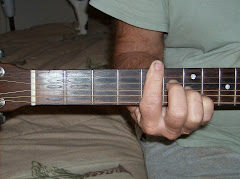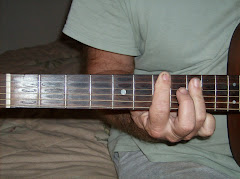In my last article we discussed how as a left handed guitar player I came to play a right handed guitar left handed by flipping over the guitar playing it backwards. This was done not to be different but out of necessity because I had to borrow someone else's guitar at the time so I couldn't restring it. Now I will discuss how to begin teaching yourself how to make chords regardless of conventional learning techniques.
Find a guitarist's chord manual or chord chart with diagrams. Even though you are playing left handed upside down, the chord fingerings have to be correct, the only difference will be which finger you will use for each guitar fret. A typical chord diagram will show an illustration of six strings and numbered round dots representing where and which finger should be pressed to make a certain chord. Remember that these diagrams are for right handed players so that means that they are intended for the left hand. We will read these diagrams and interpret for the right hand. Look at any chord diagram. It will show six strings and about seven frets. You should already know the names of the strings, E A D G B E. There is a low E and a high E string. As you hold the guitar, the high E string will be on top of the sound hole and the low E on the bottom. The high E string is located at the far right of the diagram, and the low E at the far left. The A string is next to the low E and so on. Pay no attention to the numbers on the round dots because they are irrelevant to the left handed player. A chord structure could use anywhere from one finger to four fingers. Start by learning one or two finger chords. Start learning three finger chords as soon as possible because there are actually very few one or two finger chords and you may get bored. Practice an upstroke with your left hand holding a pick. Experiment with the different fingerings to decide which fingers feel best on which strings. Also practice changing from one chord to another to get the feel of it. I have actually taught right handed people to play the guitar and my number one rule is DO NOT over practice. It leads to frustration and boredom and that is what we want to avoid. Thirty minute sessions per day is plenty of time, but if you are eager and want to work longer feel free to, I only want you to avoid getting frustrated or bored. Your fingertips will get sore but that will go away as you wear callouses on them. I hope that this helps you to get started playing right handed guitar left handed. The whole point is that as a left handed guitar player, there is no need to conform to a right handed world to learn to play music.
Wednesday, November 14, 2007
Chords And Finger Positions
Posted by
Ben Willis
at
10:20 AM
![]()
![]()
Labels: guitar, left handed, left handed guitar, Music, right handed, right handed guitar
Subscribe to:
Post Comments (Atom)
Ben Willis demonstrating the "left handed upside down guitar method".

A chord


B Chord


C Chord


D Chord


E Chord


F Chord


G Chord


B Barre Chord


D Barre Chord

Contact Info
E-mail Ben Willis at
bwillismusic@gmail.com
bwillismusic@gmail.com
Links To Other Sites
- Accordion Music
- Bass Clarinet
- Ben Willis Soundclick Page
- Celtic folk by Kevin Edward Rose
- Custom Made Left Handed Guitars
- Esteban Guitar Lessons
- Guitar Blog
- Guitar Lessons At infinateguitar.com
- Guitar Repair Bench/ A site dedicated to providing the best instructional articles about guitar repair, maintenance, and guitar building on the web, so you can repair your own guitars.
- Guitar Tab College
- Guitar Tabs
- Guitar Tabs
- Guitar Tips
- Guitarwar.com
- How To Play The Violin
- Learn How To Play Guitar Online
- Learn To Play Guitar
- Left Handed Guitars At Affordable Prices
- Lefty Guitar Trader: Guitar Forum
- LeftyFretz/ Devoted To The Left Handed Guitar Player
- Metronome
- Piano Lessons
- Rock Guitar Lessons/ Best Electric Guitar Lessons
- Single Of The Day
- Sound Tempest
- The Beatles Lyrics
- The Fifth Wheel
- The Left Handed Page
- The Left Handed Site
- The Musicians Forum/ Helping Musicians Turn Into Masters/ Free Lessons
- Upside Down Guitar On Facebook
- Used Ibenez
- Yamaha Keyboards & Guitars
- You Rock Collection








Thanks Ben! I am primarily a lefty drummer. I have made several previous attempts to play guitar (right handed) without much success, became easily frustrated, and quit....
ReplyDeleteEarly last year, I was looking around the guitar shop while waiting for my son to finish his bass lesson, and I spied a nice lefty acoustic, and decided I would give it another try. Once again, I found myself giving up in frustration. This time, I took it back to the guitar shop and traded it in for a nice classical righty guitar, and I began playing it upside down. I was interrupted for a few months due to moving, but I'm now back at it, and finding it enjoyable this time.
It's nice to find your info on the web - very helpful and inspiring. I have this and your website bookmarked now and will be checking back frequently looking for updates :-)
Thanks Miranda, Good move on the classical. The wide fret board will allow you to make chords without muffling the strings and the nylon strings will be easy on the fingers. I would suggest that you find a book with chords to a song that you already know well in your head. Practice making chords and singing at the same time. Once you have that song down you will be inspired to learn more. Also make sure that the guitar is properly tuned to standard tuning. An electronic tuner can cost as little as $10. Best of luck, Ben
ReplyDeleteBen - thank you soooo much for your brilliant website. I just picked up a right-handed acoustic Fender because I want to be to play just any ole' guitar, but I playing right-handed felt so incredibly strange. Your website is perfect! Playing upside-down feels so much more natural, and I love having a slightly quirky bent to my guitar style. Thanks again!
ReplyDeleteHey Ben,
ReplyDeleteI started playing my sisters classical guitar when I was 11 yrs old. As a lefty I had no idea what was right or left and just started learning Beatles songs by ear. I joined my first band when I turned 15 as a singer. During one jam I picked up my buddies electric six string flipped it over and started to play. The guys freaked out then were amazed I could actually do it. Until then I somehow never realized there was a difference. Other then a few cords that are challenging there really isn't any problem. Thanks for the space.
Rock on- Tim M.
Tim, Thanks for dropping in. I get funny looks when I'm playing too.
ReplyDeleteKeep at it. Ben
Great stuff. I've been attempting to play this way for a while. I've restrung to true lefty but actually feel more at ease reversed. The fingering pics u posted are awesome, a great help. Thanks a lot for this post and to people like u who do things as they feel they should. I've been playing bass this way for a while but never really hunkered down to get serious with the 6 string. You've inspired me. After seeing the pics it opened the flood gates. Thank u kind sir. You are in your right mind.
ReplyDelete